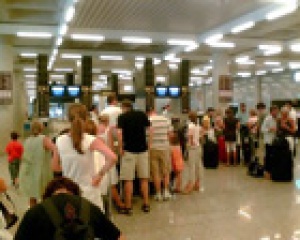Ash backlog leaves hundreds stranded in airport basement

Hundreds of tourists remain stranded in the basement of Bangkok airport as airlines struggle to clear the backlog caused by the ash cloud crisis. The recent spate of civil disturbances also makes it safer to remain in the airport rather than staying at local hotels.
The floor of the departure lounges were covered with mats and sleeping bags while passengers, mainly European holidaymakers, await repatriation.
The UK Foreign Office has advised travellers to remain in the basement of Suvarnabhumi Airport to reduce of the risk of being caught up in violent anti-government protests.
Many were left to sleep on cardboard mats after their money ran out because non-EU airlines including Thai Airways, the national carrier, are under no legal obligation of offer food or accommodation.
They are among an estimated 35,000 British travellers still stranded overseas following the grounding of all flights in and out of UK airspace earlier this month.
ADVERTISEMENT
Airlines were aiming to have collectively brought 100,000 passengers back to the UK by this weekend but there were warnings that flights from long haul destinations including Egypt, South Africa, Malaysia and Thailand could remain backlogged still next month.
Millions of travellers around the world were stranded when airspace across Europe was closed for six days following warnings that a massive plume of ash, capable of grounding aircraft had drifted across from Iceland.
However it emerged over the weekend that volcanic ash in the skies around Britain never reached more than a fraction of dangerous levels throughout the crisis which followed the eruption of Eyjafjallajökul in Iceland.
Scientists who analysed samples of powder collected during the six-day shutdown of British airspace confirmed that concentrations were only ever about one seventh of the new safety limit agreed by the aviation authorities.
It means that the closure of European airspace on safety grounds was unnecessary.
The closure of airspace came after the Met Office published projections appearing to show potentially dangerous levels of ash stretching as far as Russia.
But it can now be disclosed that they included areas where concentrations were as low as ten percent of what has since been agreed to be dangerous.

